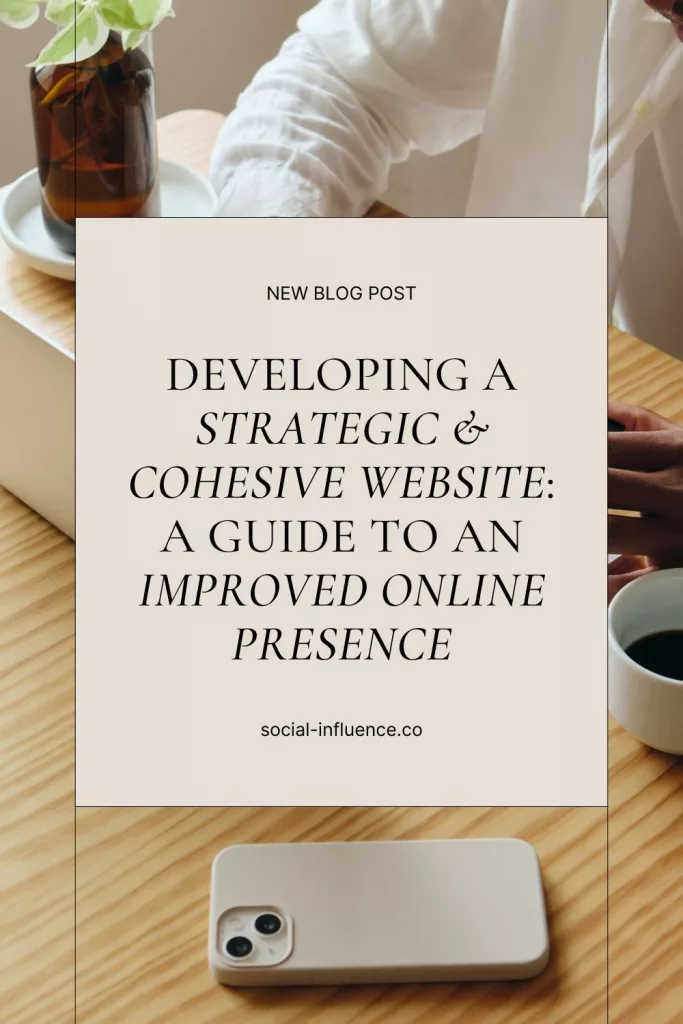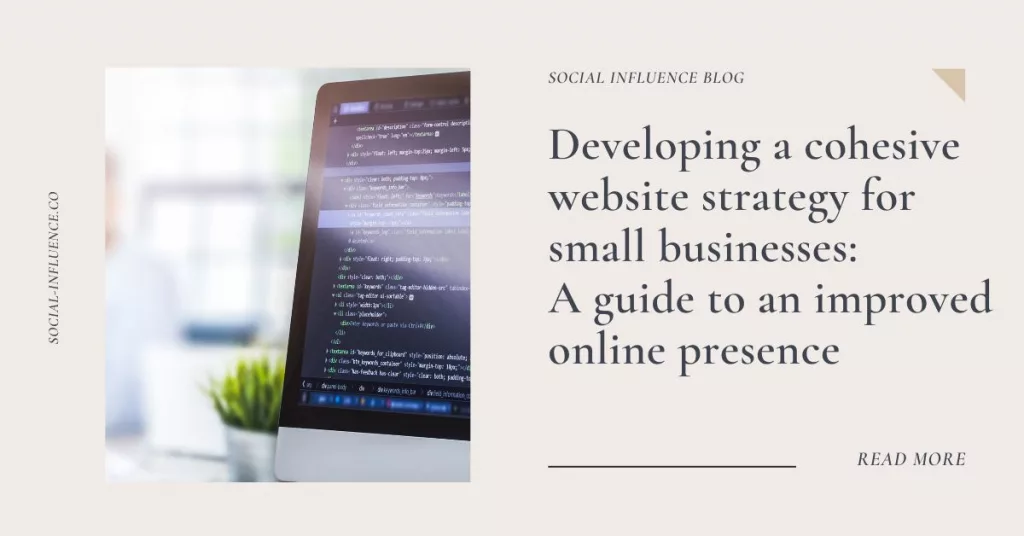|
Getting your Trinity Audio player ready...
|
A strategic and cohesive website is the cornerstone of a successful online presence. It represents your brand and serves as the primary point of contact for your audience. A well-designed website can help you attract and retain customers, improve your search engine rankings, and establish a strong online reputation. In this blog post, we will define what a strategic and cohesive website is, discuss its importance, and provide tips on how to create one. Whether you’re launching a new website or revamping an existing one, this guide will help you create a website that is both effective and memorable.
What is a strategic website?
A strategic and cohesive website is a website that is designed and developed with clear goals and objectives in mind, and that presents a consistent and unified brand experience to users. It is a website that is designed with the user in mind, optimized for search engines, and accessible on all devices.
A strategic website has a clear structure, and intuitive navigation, and is optimized for user engagement and conversions.
What is a cohesive website?
A cohesive website, on the other hand, presents a consistent and recognizable visual identity, tone of voice, and messaging throughout all its pages. The combination of these two elements results in a website that not only looks good and is easy to use, but also effectively communicates the unique value proposition of a brand to its target audience.
Importance of having a strategic and cohesive website
Having a strategic and cohesive website is important for several reasons:
- Improved User Experience: A website that is both strategic and cohesive provides a better user experience, making it easier for visitors to find the information they need and take the desired actions.
- Increased Conversion Rates: A website that is optimized for user engagement and conversions is more likely to convert visitors into customers. A cohesive visual identity and consistent messaging also help to build trust and credibility with users.
- Better Search Engine Rankings: A website that is optimized for search engines, such as Google, is more likely to rank higher in search results. This can lead to increased visibility and traffic to the site.
- Enhanced Brand Reputation: A website that presents a consistent and professional image helps to enhance the reputation of a brand. It shows that a business takes its online presence seriously and is dedicated to providing a high-quality user experience.
- Cost-Effective Marketing: A well-designed website can be a cost-effective marketing tool, providing a 24/7 online presence for a business and allowing it to reach a wider audience.
Characteristics of a Strategic Website
The success of a website is largely determined by its strategic design and development. A strategic website is one that is built with clear goals and objectives in mind, and that is optimized for user engagement and conversions.
Clear and Defined Objectives:
A strategic website starts with clear and defined objectives, such as increasing conversions, improving brand reputation, or providing a better user experience. For example, the website of a local restaurant might have the objective of providing customers with easy access to menus, hours, and online ordering, all while showcasing the restaurant’s unique offerings and atmosphere.
User-Centred Design:
A user-centred design approach focuses on the needs and wants of the target audience, making the website more effective in meeting its objectives. For example, the website for a fitness company might feature a clean, easy-to-use interface and clear calls to action to encourage users to sign up for classes or purchase products.
SEO Optimization:
SEO optimization is a key component of a strategic website. Because this ensures that the website is easily discoverable by search engines and users. For example, blogs can feature keyword-rich content and meta descriptions to improve their search engine rankings and drive more organic traffic.
Mobile Responsiveness:
With the growing use of mobile devices to access the internet, mobile responsiveness is crucial for a website. Providing a positive user experience across all devices is a must have. For example, a travel website might feature a mobile-responsive design that adjusts the layout and content to fit smaller screens. This makes it easier for users to book flights, hotels, and activities while on the go.
Characteristics of a Cohesive Website
A cohesive website is one that presents a consistent and recognizable visual identity, tone of voice, and messaging throughout all its pages. It is an essential component of a successful online presence, as it helps to build trust and credibility with users.
Consistent Branding and Visual Identity:
A cohesive website is one that presents a consistent and recognizable brand identity across all pages and elements. For example, Nike’s website features a recognizable colour scheme, font, and logo, creating a consistent look and feel that reinforces the brand’s identity.
Intuitive Navigation:
A website with intuitive navigation makes it easy for users to find the information they need and complete tasks. For example, Airbnb’s website has a clear and simple navigation bar, allowing users to quickly access different sections of the website and find the information they need.
User-Friendly Layout:
A user-friendly layout is essential for a positive user experience. For example, Apple’s website features a clean, simple, and minimalist design, making it easy for users to find and interact with the information they need.
Consistent Content and Tone:
Consistent content and tone help to reinforce a brand’s identity and build trust with users.
Benefits of a Strategic and Cohesive Website
Improved User Experience:
A strategic and cohesive website that is designed with the user in mind can provide a positive, engaging, and easy-to-use experience for visitors. This can lead to increased engagement, time on site, and user loyalty.
An example of a website that provides a positive, engaging, and easy-to-use experience for visitors is the online retail giant Amazon.com. The website is designed with the user in mind, providing clear and intuitive navigation, high-quality product images and descriptions, and a user-friendly checkout process. Amazon also incorporates user reviews and recommendations, making it easy for customers to find the products they need and make informed purchasing decisions. The result is a website that provides a seamless and enjoyable user experience, leading to increased engagement and customer loyalty.
Increased Conversion Rates:
A website that is optimized for conversion, with clear calls to action and a user-centred design, can lead to higher conversion rates. This can help to drive revenue and grow the business.
For example, an e-commerce website that focuses on creating a seamless user experience and makes it easy for customers to find and purchase products will likely see an increase in conversion rates compared to a website with a confusing layout and limited product information.
Better Search Engine Rankings:
A website that is optimized for search engines, with a clear structure, optimized content, and high-quality links, can achieve better search engine rankings. This can lead to increased visibility and organic traffic.
Enhanced Brand Reputation:
A cohesive website that presents a consistent and recognizable visual identity, tone of voice, and messaging can enhance a brand’s reputation. In addition, it builds trust with its audience. A strong online presence can help to establish a business as a leader in its industry and increase brand recognition and loyalty.
Tips for Creating a Strategic and Cohesive Website
Start with a Solid Website Strategy:
Before beginning the design and development process, it’s important to have a clear understanding of your goals and objectives. A solid website strategy should outline the target audience, desired user experience, and key performance indicators (KPIs) for the site.
Conduct User Research:
Understanding the needs and behaviours of your target audience is key to creating a user-centred website. User research can be conducted through surveys or user testing. With these you can gain insights into the needs and expectations of your audience.
Invest in Professional Design and Development:
A well-designed and developed website is crucial for delivering a positive user experience and achieving your goals. Investing in professional design and development can help ensure that your website is both strategic and cohesive.
Continuously Monitor and Optimize Your Website:
Your website is a living entity that needs to be continually monitored and optimized to remain effective. Regularly analyzing website traffic and engagement data, and making updates and improvements as needed, can help to ensure that your website remains effective over time.

Recap of Key Points
In this blog post, we discussed the definition of a strategic and cohesive website. And the importance of having one for a successful online presence. We also explored the characteristics of a strategic and cohesive website, as well as tips for creating one.
Final Thoughts
A strategic and cohesive website is crucial for building a successful online presence and achieving business goals. By creating a website that is optimized for user engagement and conversions, presents a consistent and recognizable visual identity and is easy to use and navigate, businesses can enhance their reputation, increase conversions, and reach a wider audience.
If you’re looking to create or update your website, invest in professional design and development. If you need help, consider working with Social Influence web design and development agency. We can provide the expertise and resources needed to create a strategic and cohesive website that effectively supports your business goals.







1 thought on “Developing a strategic and cohesive website for small businesses: A guide to an improved online presence”
Pingback: Secrets of How To Choose the Right Web Development Company in Malaysia | Lamanify